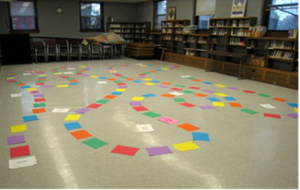9 Non-Digital Games
Carrie Lewis Miller
Learning Objectives
- Describe the use of non-digital games in educational or training contexts
- Create a non-digital game solution to an educational or training problem
Non-digital games, also known as analog games, are any type of game that is not played on a digital device (computer, game console, phone, or tablet). Board games, card games, and sports games are examples of non-digital games.
Implementing non-digital games into a learning experience can be much cheaper and faster than attempting a serious or other digital game. Some non-digital games require nothing more than a piece of paper and a pencil, such as BINGO. Commercial board games can be adapted to suit the content or can be recreated using the same game mechanics and appearance of a game. Card games make great review strategies and there are currently many commercial card games available that can serve that purpose, such as Miles Bornes or Memory.
Non-digital games can be exciting and creative ways for your students to express their understanding of the content. Game creation as an assessment option offers learners opportunities to reach higher cognitive domain levels on Bloom’s Taxonomy while demonstrating what they have learned. In addition, encouraging students to play one another’s games is a great way to build communities of learning.
Empirical studies around the use of non-digital games, such as board games, in learning environments, show that students achieve higher learning gains and have a higher rate of satisfaction with the learning experience (Anyanwu, 2014; Lee et al., 2015).
Possibly the greatest benefit to non-digital games is that they can be played anywhere. Whether your organization has a budget or not, whether your learners have access to technology or not, non-digital games are a way to implement Game-Based Learning without money or technology concerns. Learners can take the games with them for on-the-go revision or they can play the game outside of training or classroom time with their co-workers or classmates.
A quick Google search will turn up a host of blank board game templates that you can use to create your own game. You can also turn your training or classroom into a game using paper and everyday items as in the Candyland library room pictured in Figure 5.

Figure 5. Manchester City Library. “Life-Sized Candyland”. 15 March, 2010. Online image. Flikr. https://flic.kr/p/7L1hLw. (CC BY-SA 2.0)
Questions for Discussion
- Make a case for the use of non-digital games as learning tools within your organization. As an instructional designer, how can you advocate for the use of non-digital games? Is there a particular learning context in which non-digital games would fit? What evidence can you provide (or cite) that will help convince others in your organization to use non-digital games?
- Reflection: What is your favorite non-digital game? How often do you play? With whom do you play? Is this different from your routine digital gameplay? Why or why not?
References
Anyanwu, E. G. (2014). Anatomy adventure: A board game for enhancing understanding of anatomy. Anatomical Sciences Education, 7(2), 153-160.
Lee, E., Moreau, K., & Lochnan, H. (2015). A customised board game enhances learning about obesity. Medical education, 49(11), 1149-1150.
Recommended Supplementary Material
- Khan, A., & Pearce, G. (2015). A study into the effects of a board game on flow in undergraduate business students. The International Journal of Management Education, 13(3), 193-201. https://doi.org/10.1016/j.ijme.2015.05.002
- *Warning – Contains Simulated Video Game Violence*

